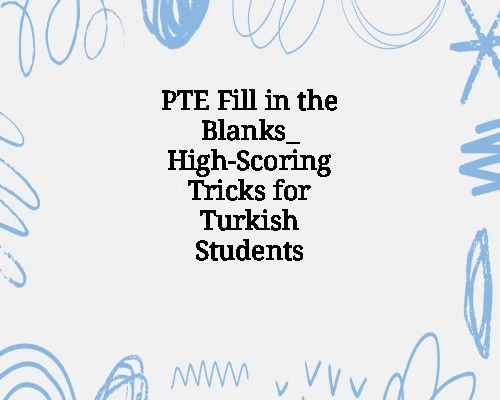PTE Fill in the Blanks_ High-Scoring Tricks for Turkish Students
PTE Fill in the Blanks: High-Scoring Tricks for Turkish Students
Boost your PTE Reading scores with proven Fill in the Blanks tricks designed specifically for Turkish learners aiming for top band scores.
Understanding the PTE Fill in the Blanks Task
The PTE Reading section includes two types of “Fill in the Blanks” (FIB) questions:
-
Reading & Writing: Fill in the Blanks: Appears in both Reading and Writing sections. You drag words into blanks.
-
Reading: Fill in the Blanks: Appears only in the Reading section. You click on words to fill blanks from drop-downs.
Each type tests grammar, vocabulary, and contextual understanding, skills Turkish students can master with focused techniques.
Why Turkish Students Struggle with FIB
Turkish students often face unique challenges in PTE Fill in the Blanks due to:
-
Different sentence structure in Turkish vs. English (Subject-Object-Verb in Turkish vs. Subject-Verb-Object in English)
-
Limited collocation awareness (words that go together naturally in English)
-
Confusion between similar-sounding words (like affect vs. effect)
These issues can be overcome with targeted strategies and consistent practice.
High-Scoring Tricks for Reading & Writing: Fill in the Blanks
1. Master English Collocations
English is full of fixed word combinations (collocations) like:
-
Make a decision, take a risk, pay attention
Use resources like Oxford Collocations Dictionary and practice identifying pairs while reading English articles or listening to English audio.
Turkish Tip: Collocations often don’t translate directly. For example, “karar almak” in Turkish becomes “make a decision” in English—not “take a decision.”
2. Use Contextual Clues
Read the entire paragraph first before filling any blanks. Look for:
-
Tone (formal/informal)
-
Theme (business, education, technology)
-
Keywords that repeat or relate
These cues will guide you toward the correct word choice.
3. Identify Parts of Speech
Before looking at options, guess what kind of word (noun, verb, adjective, adverb) fits each blank:
-
“The ___ student worked hard.” → Likely an adjective (e.g., “diligent”)
Turkish Tip: English word order usually follows adjective + noun, while Turkish often places adjectives differently. Practice identifying English parts of speech.
4. Check for Prepositions and Articles
Certain verbs and adjectives always come with specific prepositions or determiners:
-
Interested in, good at, responsible for
-
An apple, a university (watch for vowel sounds!)
Incorrect use changes the meaning and costs you marks.
5. Eliminate Wrong Options Logically
For each blank:
-
Remove options that don’t match grammar
-
Remove options that don’t fit the tone or meaning
-
Prioritize words that are commonly used collocations
Even if you’re unsure, reducing the choices increases your chance of getting it right.
High-Scoring Tricks for Reading: Fill in the Blanks
1. Practice Synonym Recognition
Many FIB questions involve synonyms:
-
increase = rise, grow
-
problem = issue, difficulty
Turkish Tip: Focus on English-English synonym pairs, not Turkish-English translations, to improve context guessing.
2. Pay Attention to Linking Words
Words like however, although, therefore, and moreover connect ideas.
Recognizing them helps you predict the sentence’s direction and select the appropriate blank:
-
She studied hard; ___, she passed with high marks. → Therefore
3. Understand Verb Tenses
Be aware of the tense used in surrounding sentences. The blank’s correct form often depends on consistency in tense:
-
He had already ___ the decision before they arrived. → made (past participle)
4. Develop Vocabulary Through Reading
The more you read academic and general English content, the more you’ll recognize natural-sounding options for blanks.
Recommended materials:
-
News sites (BBC, CNN)
-
Academic articles (on education, business, tech)
-
PTE practice texts
Vocabulary Themes Turkish Students Should Focus On
Building topic-specific vocabulary helps predict blanks more accurately. Focus on:
Education
-
curriculum, discipline, assessment, instructor, syllabus
Technology
-
innovation, data, algorithm, virtual, digital
Business
-
profit, revenue, market, transaction, strategy
Environment
-
sustainability, ecosystem, climate, pollution, renewable
Daily Practice Plan for Turkish Students
Day 1–2: Collocation Practice
-
Study 30 common academic collocations daily.
-
Use flashcards (Quizlet, Anki).
Day 3–4: Grammar Review
-
Focus on tenses, prepositions, and articles.
-
Complete fill-in-the-blank grammar exercises.
Day 5–6: Reading Practice
-
Read one academic article daily.
-
Highlight unfamiliar words and identify parts of speech.
Day 7: Mock FIB Practice
-
Use PTE mock tools (e.g., PTE Practice app, Pearson portal).
-
Focus on time management: 30–40 seconds per blank.
Best Online Tools for FIB Mastery
-
PTE Tutorials – Daily quizzes and mock tests
-
EnglishCollocation.com – Great for mastering collocations
-
Grammarly Blog – Useful grammar explanations and examples
-
Quizlet – Make vocabulary sets and test yourself
Scoring Insights
Each correct blank is scored independently. There’s no partial credit within blanks, so:
-
Don’t leave any blanks empty.
-
Even a guessed answer could be correct.
-
Never waste time on one difficult blank—move on and return later.
What to Avoid in PTE FIB
-
Don’t translate from Turkish. Always think in English.
-
Don’t rely only on grammar—context matters too.
-
Don’t overlook small words like prepositions—they are often the key to correct answers.
-
Don’t panic if one blank seems impossible—stay calm and move to the next.
Final Advice for Turkish Test-Takers
-
Immerse yourself in English as much as possible: switch your device language, follow English YouTube channels, listen to English podcasts.
-
Join Telegram or Facebook groups with other Turkish PTE aspirants.
-
Track your progress weekly. Measure your accuracy and speed with real exam-style questions.
With smart strategies, consistent practice, and the right mindset, even the most challenging Fill in the Blanks questions can be tackled confidently.
Conclusion
For Turkish students preparing for the PTE exam, mastering the Fill in the Blanks sections is a strategic way to boost overall reading and writing scores. By focusing on collocations, grammar accuracy, contextual reading, and consistent vocabulary development, you’ll be well on your way to securing top marks.





